Key points about I Adore You
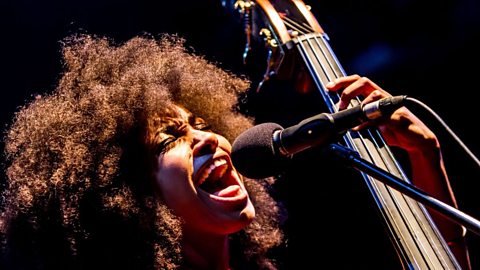
• Esperanza Spalding is an award-winning American jazz singer, bassist and composer.
• Spalding taught herself to play the violin from a young age and after trying various instruments, she settled on the bass.
• Spalding spent time in Brazil, studying Portuguese and Latin American music, including Brazilian samba and bossa nova.
• This work is a fusion piece - when two or more styles/traditions are mixed together. In I Adore You, Spalding creates music that combines jazz with the Latin style of samba, as well as elements of Afro Cuban music.
• I Adore You features on her album Esperanza, which was released in 2008.


Remember
I Adore You is one of the three songs by Spalding which are the study pieces for Area of Study 2 for your AQA GCSE listening exam.
The other two are:
Video
Watch the video below to learn more about the structure, vocal, instrumental and other musical features used in I Adore You.
Presenter: Esperanza Spalding is an American jazz bassist and singer songwriter. Her love song I Adore You is from her 2008 album Esperanza. It features samba polyrhythms using shakers, kaisha, and solo drums.
Unusually, the time signature swaps between 3/4 and 2/4 throughout the piece. It has a loose AB structure with improvised instrumental solos on the piano and bass with vocals.
The vocal line is improvised over the bass solo. This style of singing is called Scat singing, a form of vocal improvisation without words.
Singer: Da da da da dom.Da da da da da.Da da da da da da da.Da da da da da da da da.Da da da da.
Presenter: The addition of the piano bassline reinforces the jazz influence and double bass and drum kit joining.Let's hear how that builds.
The song ends with a repeated full bar chord pattern, over which the soloist improvise, gradually fading out to leave the opening samba rhythms.
Listen out for the Latin American style vocal calls.
Group singing: La la la.La la la, oh hey oh.La la lay.La la la la la, oh lay oh.La la la la la la la la la lay oh.La la la la la la la lay oh.
Structure
The structure of this piece is divided into sections. Despite having no lyrics it can be interpreted as strophicA musical form in which a verse or passage is repeated. A strophic song refers to music in which every verse or chorus is sung to the same music. with some melodic and rhythmic ideas being repeated and developed.
| Section | Timings | Time signature | Musical features |
|---|---|---|---|
| Unpitched introduction | 0:00-0:30 | 3/4 | Samba instruments fade in, including an ocean drum. |
| Pitched introduction | 0:31-0:43 | 3/4 | The voice/s enter, shortly followed by the double bass. This plays the same groove as in the main chorus. Vocals could be described as a verse. |
| Pitched introduction continued | 0:44-0:55 | 3/4 | Vocals are in thirds. Piano motif enters. Double bass features are as above. |
| Bridge | 0:56-1:09 | 2/4 | New vocal idea followed by entry of the drum kit. |
| Main groove/chorus | 1:09-1:22 | 3/4 | Vocals are upbeat. There are 3 repeating motifs layered together. |
| Verse | 1:23-1:41 | 2/4 | Vocals start with the same anacrusis as the pitched introduction. |
| Development of the verse | 1:41-1:53 | 2/4 | Spalding's melody starts with a descending 4th and is generally lower in the vocal range. |
| Main grove/chorus | 1:53-2:07 | 3/4 | As before - this is characterised by the repeated notes in the vocals. |
| Verse variant | 2:07-2:26 | 2/4 | Starts as a repeat of the verse but develops into a new direction. |
| Bridge | 2:26-2:37 | 2/4 | Same as the previous bridge. |
| Solo section | 2:37-4:10 | 2/4 | The vocals stop. First solo is taken by the piano accompanied by drumkit and bass. Second solo starts at 3:25 and is taken by the voice and double bass. |
| Main groove/chorus | 4:10-4:36 | 3/4 | Starts with the vocal and bassline merging into a new crotchet pattern. Familiar piano chords and bass repeat. |
| Verse variant | 4:36-4:51 | 2/4 | Same as the previous variant at the start and then becomes different. |
| Verse | 4:51-5:10 | 2/4 | Same as the verse which starts at 1:23. |
| Development of the verse | 5:10-5:22 | 2/4 | Same as the development of the verse which starts at 1:41. |
| Verse variant | 5:22-5:52 | 2/4 | Similar material to before but takes a new direction. |
| Main groove/chorus | 5:52-7:10 | 3/4 | Many repeats of the familiar riffs. The vocals go higher and higher in pitch. Samba instruments come in. |
| Outro | 7:10-end | 3/4 | Samba instruments are left by themselves and then fade. |

Remember
Approximate timings are placed here for reference, but it is not necessary to study the score for your exam.
Vocal features
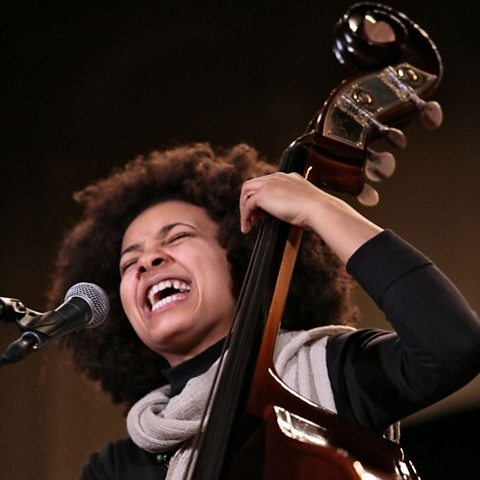
Spalding is known for her silky smooth vocals and how they interact with her funky basslines, this is evident in I Adore You.
She sings mainly in an alto range, but often her vocal improvisations extend beyond this.
• One of the most notable features of the Spalding’s vocals is her scatWhen the singer improvises using nonsense syllables or no words at all, sometimes using the voice to mimic instruments. improvisations. I Adore You is full of these, including some repeated riffs which are presented by the backing vocals.
• The improvisations are much more extensive than the other two songs which are being studied for AQA GCSE.

Question and answer
What is the term used for wordless improvisation using nonsense sounds?
Scatting
Instrumental features
The combination of instruments used in I Adore You contributes to an overall fusion sound of jazz and samba:
• The bass line, along with the piano and drum kit are the rhythm section which drive the song forward with syncopated bass lines and rhythms, typical of jazz.
• The double bass part is also improvised along with the voice in the solo section, giving Spalding an opportunity to demonstrate her skill.
• The piano also improvises in the solo section, again typical of the jazz tradition.
The addition of samba instruments at the start and end of the track demonstrate Spalding’s studies of the style. The following instruments can be heard in the intro and outro:
Surdo
A large cylindrical metal-framed bass drum.
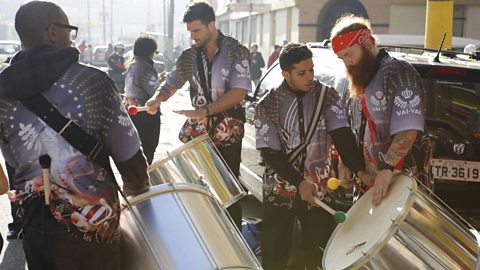
Cabasa
A hand held percussion instrument with a round wheel or cylinder, usually made of wood and looped with a steel ball chain.
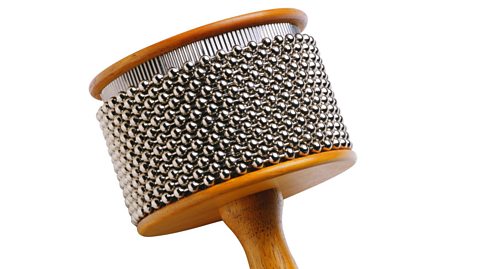
Shekere
Dried gourd with woven netting of beads covering the gourd.

Repinique
A two-headed Brazilian drum.
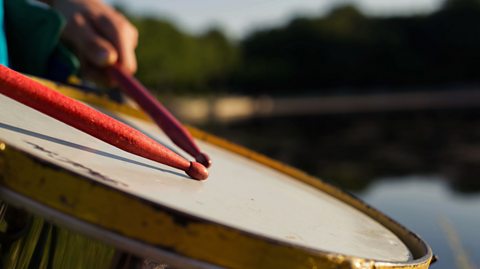
Caixa
A Brazilian snare drum
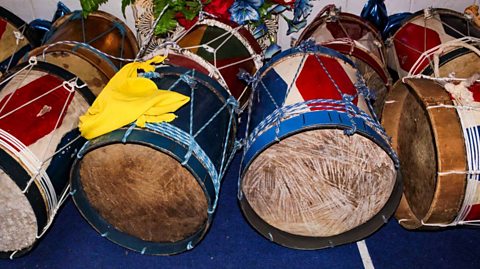
Conga
A tall, narrow, single-headed drum that brings an Afro Cuban influence to the music.
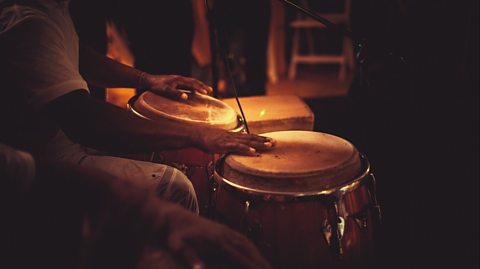
Other musical features
Spalding uses the following musical elements to create her unique sound:
Tonality and harmony
The main groove/chorus suggests G mixolydian, with a bass line of G and D, with F naturals. G mixolydian is a mode which is common in jazz. The verses use a lot of chromatically altered chords, which contribute to dissonance in the track.
There are also chromatic notes added to the chords and melodies which contribute to unclear tonality. The introduction and outro have unpitched percussion and so therefore have no tonality.
Melody
There are two main vocal hooks.
One characterises the verse, and the other the main groove/chorus. There is often an anacrusisUpbeat. One or more tones preceding the first downbeat of a musical phrase. to these hooks. These are repeated and developed throughout the song. The first vocal hook features a long sustained note, whereas the second hook contains repeated notes on the same pitch. The bass acts as an anchor between G and D and the riff rocks up and down the interval of an octave.
The piano plays mainly chords but is introduced with a disjunct melodyA melody which moves in leaps, using larger intervals than a 2nd.
Tempo, metre and rhythm
Tempo
The underlying beat of the music.
Metre
The organisation of rhythms into certain regular patterns.
Rhythm
The organisation of particular sounds by their length.
This song is moderately fast. The piece starts and finishes in 3/4 time but the metreThe organisation of rhythms into certain regular patterns frequently changes between 3/4 and 2/4.
It is sometimes difficult to feel the first beat of the bar, especially with the syncopations. As is typical of both jazz and samba, there are many syncopated rhythms, especially from the piano and double bass. In the main groove/chorus, the music is polyrhythmic, with each layer of rhythm being syncopated.
Texture
The texture is predominantly melody and accompaniment. There are some moments where the music is almost polyphonic, where there are different parts playing different rhythms, like in the main groove/chorus.
Find out more about texture in music.
Dynamics
The fading in of instruments in the introduction is a crescendo. The opposite happens in the outro.
I Adore You quiz
More on Traditional music
Find out more by working through a topic